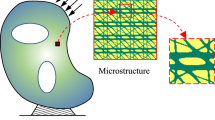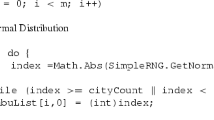Abstract
This paper proposes a novel ant colony hyperheuristic approach for reordering the rows and columns of symmetric positive definite matrices. This ant colony hyperheuristic approach evolves heuristics for bandwidth reduction applied to instances arising from specific application areas with the objective of generating low-cost reordering algorithms. This paper evaluates the resulting reordering algorithm in each application area against state-of-the-art reordering algorithms with the purpose of reducing the running times of the zero-fill incomplete Cholesky-preconditioned conjugate gradient method. The results obtained on a wide-ranging set of standard benchmark matrices show that the proposed approach compares favorably with state-of-the-art reordering algorithms when applied to instances arising from computational fluid dynamics, structural, and thermal problems.

Similar content being viewed by others

References
Ajiz MA, Jennings A (1984) A robust incomplete Choleski-conjugate gradient algorithm. Int J Numer Methods Eng 20:949–966
Bathe K (1996) Finite element procedures. Prentice Hall, New Jersey
Benzi M (2002) Preconditioning techniques for large linear systems: a survey. J Comput Phys 182:418–477
Benzi M, Tuma M (2003) A robust incomplete factorization preconditioner for positive definite matrices. Numer Linear Algebra Appl 10:385–400
Bernardes JAB, Gonzaga de Oliveira SL (2015) A systematic review of heuristics for profile reduction of symmetric matrices. Procedia Comput Sci 51:221–230. https://doi.org/10.1016/j.procs.2015.05.231
Camata JJ, Rossa AL, Valli AMP, Catabriga L, Carey GF, Coutinho ALGA (2012) Reordering and incomplete preconditioning in serial and parallel adaptive mesh refinement and coarsening flow solutions. Int J Numer Methods Fluids 69(4):802–823
Chagas GO, Gonzaga de Oliveira SL (2015) Metaheuristic-based heuristics for symmetric-matrix bandwidth reduction: a systematic review. Procedia Comput Sci 51:211–220. https://doi.org/10.1016/j.procs.2015.05.229
Davis TA, Hu Y (2011) The University of Florida sparse matrix collection. ACM Trans Math Softw 38(1):1–25
Dorigo M, Stützle T (2003) The ant colony optimization metaheuristic: algorithms, applications, and advances. In: Glover FW, Kochenberger GA (eds) Handbook of metaheuristics. International series in operations research and management science, vol 57. Springer, Boston, pp 250–285
Gao J, Liang R, Wang J (2014) Research on the conjugate gradient algorithm with a modified incomplete Cholesky preconditioner on GPU. J Parallel Distrib Comput 74:2088–2098
George A (1971) Computer implementation of the finite element method. Ph.D. thesis, Stanford University, Stanford
George A, Liu JW (1981) Computer solution of large sparse positive definite systems. Prentice-Hall, Englewood Cliffs
George A, Liu JWH (1979) An implementation of a pseudoperipheral node finder. ACM Trans Math Softw 5(3):284–295
Gkountouvas T, Karakasis V, Kourtis K, Goumas G, , Koziris N (2013) Improving the performance of the symmetric sparse matrix-vector multiplication in multicore. In: 27th international symposium on parallel and distributed processing (IPDPS). IEEE Computer Society, Boston, pp 273–283
Golub GH, van Loan CF (1996) Matrix computations, 3rd edn. The Johns Hopkins University Press, Baltimore
Gonzaga de Oliveira SL, Abreu AAAM (2018) An evaluation of pseudoperipheral vertex finders for the reverse Cuthill–McKee method for bandwidth and profile reductions of symmetric matrices. In: 37th international conference of the Chilean Computer Science Society (SCCC). Chilean Computer Science Society, Santiago, Chile. https://ieeexplore.ieee.org/document/8705263
Gonzaga de Oliveira SL, Bernardes JAB, Chagas GO (2018) An evaluation of low-cost heuristics for matrix bandwidth and profile reductions. Comput Appl Math 37(2):1412–1471
Gonzaga de Oliveira SL, Bernardes JAB, Chagas GO (2018) An evaluation of reordering algorithms to reduce the computational cost of the incomplete Cholesky-conjugate gradient method. Comput Appl Math 37(3):2965–3004
Gonzaga de Oliveira SL, Chagas GO (2015) A systematic review of heuristics for symmetric-matrix bandwidth reduction: methods not based on metaheuristics. In: Proceedings of the Brazilian symposium on operations research (SBPO 2015), Sobrapo, Pernambuco, Brazil
Hestenes MR, Stiefel E (1952) Methods of conjugate gradients for solving linear systems. J Res Natl Bur Stand 49(36):409–436
Hu Y, Scott JA (2001) A multilevel algorithm for wavefront reduction. SIAM J Sci Comput 23(4):1352–1375
Iwashita T, Mifune T, Shimasaki M (2007) Evaluation index of acceleration factor and ordering in shifted ICCG method for electromagnetic field analyses. IEEE Trans Magn 43(4):1493–1496
Jansen KE, Rasquin M, Farnsworth JA, Rathay N, Monastero MC, Amitay M (2018) Interaction of a synthetic jet with separated flow over a vertical tail. AIAA J 56(7):2653–2668
King IP (1970) An automatic reordering scheme for simultaneous equations derived from network systems. Int J Numer Methods Eng 2(4):523–533
Konshin I (2016) Parallel computational models to estimate an actual speedup of analyzed algorithm. In: Voevodin V, Sobolev S (eds) Supercomputing, second Russian supercomputing day, RuSCDays 2016. Communications in computer and information science. Springer, Moscow, pp 304–317
Koohestani B, Poli R (2011) A hyper-heuristic approach to evolving algorithms for bandwidth reduction based on genetic programming. In: Research and development in intelligent systems XXVIII. Springer, London, pp 93–106
Kumfert G, Pothen A (1997) Two improved algorithms for envelope and wavefront reduction. BIT Numer Math 37(3):559–590
Lanczos C (1952) Solutions of systems of linear equations by minimized iterations. J Res Natl Bur Stand 49(1):33–53
Li L, Huang TZ, Jing YF, Zhang Y (2010) Application of the incomplete Cholesky factorization preconditioned Krylov subspace method to the vector finite element method for 3-D electromagnetic scattering problems. Comput Phys Commun 181:271–276
Lin YX, Yuan JJ (1994) Profile minimization problem for matrices and graphs. Acta Math Appl Sin 10(1):107–122
Medeiros SRP, Pimenta PM, Goldenberg P (1993) Algorithm for profile and wavefront reduction of sparse matrices with a symmetric structure. Eng Comput 10(3):257–266
Papadimitriou CH (1976) The NP-completeness of bandwidth minimization problem. Comput J 16:177–192
Rasquin M, Smith C, Chitale K, Seol ES, Matthews BA, Martin JL, Sahni O, Loy RM, Shephard MS, Jansen KE (2014) Scalable implicit flow solver for realistic wing simulations with flow control. Comput Sci Eng 16(6):13–21
Reid JK, Scott JA (1999) Ordering symmetric sparse matrices for small profile and wavefront. Int J Numer Methods Eng 45(12):1737–1755
Reid JK, Scott JA (2002) Implementing Hager’s exchange methods for matrix profile reduction. ACM Trans Math Softw 28(4):377–391
Semba K, Tani K, Yamada T, Iwashita T, Takahashi Y, Nakashima H (2013) Parallel performance of multithreaded ICCG solver based on algebraic block multicolor ordering in finite element electromagnetic field analyses. IEEE Trans Magn 49(5):1581–1584
Sloan SW (1989) A Fortran program for profile and wavefront reduction. Int J Numer Methods Eng 28(11):2651–2679
STFC: The Science and Technology Facilities Council (2018) HSL. A collection of Fortran codes for large scale scientific computation. http://www.hsl.rl.ac.uk. Accessed Dec 2018
Toivanen J, Avery P, Farhat C (2018) A multilevel FETI-DP method and its performance for problems with billions of degrees of freedom. Int J Numer Methods Eng 116(10–11):661–682
Williams S, Waterman A, Patterson D (2009) Roofline: an insightful visual performance model for multicore architectures. Commun ACM 52(4):65–76
Wout E, van Gijzen MB, Ditzel A, van der Ploeg A, Vuik C (2012) The deflated relaxed incomplete Cholesky CG method for use in a real-time ship simulator. Procedia Comput Sci 1:249–257
Acknowledgements
The Coordenação de Aperfeiçoamento de Pessoal de Nível Superior (CAPES) supported the development of this work. The ant colony image used in Fig. 1 is a free image taken from https://pixabay.com/photos/anthill-ant-insect-nature-colony-140643.
Author information
Authors and Affiliations
Corresponding author
Additional information
Publisher's Note
Springer Nature remains neutral with regard to jurisdictional claims in published maps and institutional affiliations.
Rights and permissions
About this article
Cite this article
de Oliveira, S.L.G., Silva, L.M. Evolving reordering algorithms using an ant colony hyperheuristic approach for accelerating the convergence of the ICCG method. Engineering with Computers 36, 1857–1873 (2020). https://doi.org/10.1007/s00366-019-00801-5
Received:
Accepted:
Published:
Issue Date:
DOI: https://doi.org/10.1007/s00366-019-00801-5



